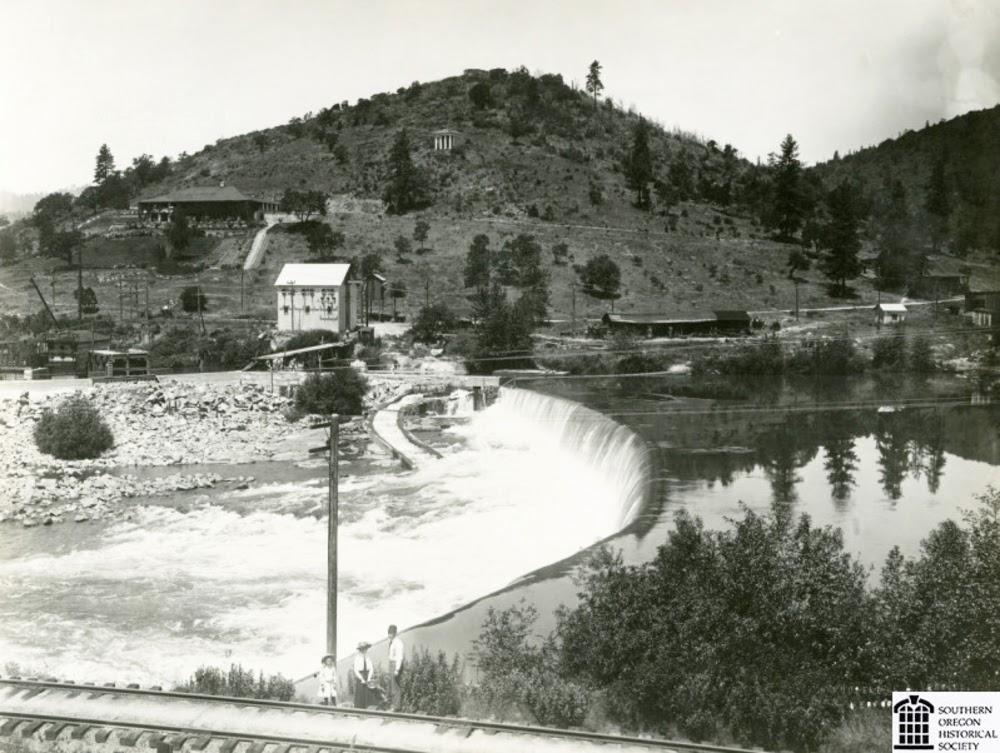 |
| Gold Ray Dam ca. 1912 Southern Oregon Historical Society <click for History> |
With Rogue River dams gone,
chinook salmon make a splash
Three years after the second of two dams were removed, Oregon’s Rogue River is “just alive with fish” spawning upstream, says a wildlife biologist.
By MARK FREEMAN
Medford Mail Tribune
GOLD HILL, Ore. — Rowing just upstream of what used to be Gold Ray Dam last month, biologist Pete Samarin saw so many fall chinook splashing wildly within the Rogue River’s gravelly riffle that he was lucky he didn’t get drenched.
By MARK FREEMAN
Medford Mail Tribune
GOLD HILL, Ore. — Rowing just upstream of what used to be Gold Ray Dam last month, biologist Pete Samarin saw so many fall chinook splashing wildly within the Rogue River’s gravelly riffle that he was lucky he didn’t get drenched.
The salmon were spawning in shallow gravel bars that three years ago were covered by 10 feet of water and at least that much silt and other fine sediments captured over 106 years behind what was Gold Ray Dam.
With the dam gone three years now and the fine sediment washed away, the bar now teems with big chinook salmon digging and spawning in their egg nests, called redds.
“That place was just alive with fish,” says Samarin, a fish biologist with the Oregon Department of Fish and Wildlife. “You couldn’t count all the redds. It was really neat to see. It’s incredible, really.”
In true if-you-remove-it-they-will-spawn fashion, fall chinook are now spawning by the hundreds in what used to be sterile sections of the Rogue inundated by water and silt behind what used to be Savage Rapids and Gold Ray dams.
Fall spawning surveys upstream of where those two dams spanned the Rogue show that use of these now-viable spawning grounds has risen exponentially since those structures were removed.
Samarin’s redd-survey crew in the fall found 186 identifiable redds in what used to be “Savage Lake” — the stagnant, pondlike water that used to be upstream of Savage Rapids Dam along Highway 99 near the town of Rogue River. That’s more than twice the 91 redds counted in that same stretch three years ago.
Likewise, the crews counted 111 redds within the old Gold Ray Reservoir reach, almost three times what was spied there three years ago.
“And we’re only counting what we can see,” Samarin says. “We can’t see everything.”
Bob Hunter could see this coming.
Removing the two dams and their antiquated fish ladders was expected to improve fish passage and eventually provide additional spawning territory for chinook salmon, which unlike steelhead spawn in the main Rogue channel.
“This is what you hope to see when you restore main-stem habitat,” says Hunter, the WaterWatch attorney who helped usher through the removal of both dams. “On the Rogue, there’s really no other place to restore habitat like that in the main stem.
“It’s good to see the chinooks using it,” he says.
Chinooks spawn in the main-stem Rogue’s shallow gravel bars and glides from late September through early November. Females use their tails to dig deep enough into the substrate to help their eggs survive winter high-water events. The males fertilize the eggs, and both males and females then die.
The redds are counted annually, with the numbers used as an index to track the relative health of the all-wild fall chinook returns over time.
With the dam gone three years now and the fine sediment washed away, the bar now teems with big chinook salmon digging and spawning in their egg nests, called redds.
“That place was just alive with fish,” says Samarin, a fish biologist with the Oregon Department of Fish and Wildlife. “You couldn’t count all the redds. It was really neat to see. It’s incredible, really.”
In true if-you-remove-it-they-will-spawn fashion, fall chinook are now spawning by the hundreds in what used to be sterile sections of the Rogue inundated by water and silt behind what used to be Savage Rapids and Gold Ray dams.
Fall spawning surveys upstream of where those two dams spanned the Rogue show that use of these now-viable spawning grounds has risen exponentially since those structures were removed.
Samarin’s redd-survey crew in the fall found 186 identifiable redds in what used to be “Savage Lake” — the stagnant, pondlike water that used to be upstream of Savage Rapids Dam along Highway 99 near the town of Rogue River. That’s more than twice the 91 redds counted in that same stretch three years ago.
Likewise, the crews counted 111 redds within the old Gold Ray Reservoir reach, almost three times what was spied there three years ago.
“And we’re only counting what we can see,” Samarin says. “We can’t see everything.”
Bob Hunter could see this coming.
Removing the two dams and their antiquated fish ladders was expected to improve fish passage and eventually provide additional spawning territory for chinook salmon, which unlike steelhead spawn in the main Rogue channel.
“This is what you hope to see when you restore main-stem habitat,” says Hunter, the WaterWatch attorney who helped usher through the removal of both dams. “On the Rogue, there’s really no other place to restore habitat like that in the main stem.
“It’s good to see the chinooks using it,” he says.
Chinooks spawn in the main-stem Rogue’s shallow gravel bars and glides from late September through early November. Females use their tails to dig deep enough into the substrate to help their eggs survive winter high-water events. The males fertilize the eggs, and both males and females then die.
The redds are counted annually, with the numbers used as an index to track the relative health of the all-wild fall chinook returns over time.
 |
| Gold Ray Dam site - 2013 River Design Group <click for PROJECT> |
